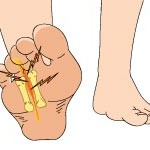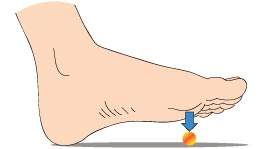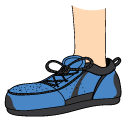What is Freiberg’s Disease?
Freiberg’s Disease (also known as Freiberg’s Infraction) is a type of osteochondroses that most commonly affects the second Metatarsal bone in the foot. Your Metatarsals are a group of 5 bones that are located in the mid-foot and are connected to your toe bones.
Freiberg’s Disease is often associated with Metatarsalgia.
Causes
 Since Freiberg’s Disease is an osteochondroses, this means that blood supply to the second Metatarsal has been cut off, or at least compromised.
Since Freiberg’s Disease is an osteochondroses, this means that blood supply to the second Metatarsal has been cut off, or at least compromised.
The potential causes of Freiberg’s Disease are not well-understood. It is believed that there may be several different factors that contribute to the development of Freiberg’s Disease, including lifestyle, genetics and environment.
Freiberg’s Disease affects preteens and teenagers who are going through puberty, and seems to affects girls more often than boys. This is thought to be related to growth spurts.
Some sources claim there is a link between Freiberg’s Disease and physical activity.
Signs & Symptoms
Signs and symptoms of Freiberg’s Disease include:
- Pain in and around the second Metatarsal bone

- Pain that worsens when bearing weight
- Pain that is worse when wearing shoes with a high heel
- Stiffness and tenderness in the affected area
- Reduced range of motion
- Feeling like you’re walking on a marble (Metatarsalgia)
Some people with Freiberg’s Disease may also walk with a limp.
Treatment Options
 Proper Footwear – Avoiding high heels and only wearing comfortable, supportive footwear is one solution to your Freiberg’s Disease symptoms.
Proper Footwear – Avoiding high heels and only wearing comfortable, supportive footwear is one solution to your Freiberg’s Disease symptoms.
Immobilization – Wearing a cast or boot is often recommended in order to prevent weight bearing.
RICE – Following the RICE method (Rest, Ice, Compression and Elevation) is an effective way to get your symptoms under control.
Painkillers – Over-the-counter painkillers such as Advil and Tylenol can be used to help relieve the pain. Just make sure you don’t take them during times whe n you’re being physically active, as painkillers mask the pain, making you unaware of any further damage you may be doing to your Metatarsal.
n you’re being physically active, as painkillers mask the pain, making you unaware of any further damage you may be doing to your Metatarsal.
Activity Modification – Trading in activities like running or dancing for activities like walking or swimming may help to lessen the stress on your Metatarsals.
Cortisone Shots – In extreme cases, cortisone shots can help to temporarily relieve pain and swelling. Be careful though, because cortisone shots come with a variety of risks and side effects.
Surgery – Most cases of Freiberg’s Disease can be resolved without surgical intervention. Surgery should only be considered as a last resort if conservative treatment methods have failed to help.